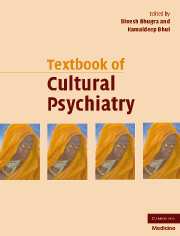Book contents
- Frontmatter
- Contents
- Contributors
- Foreword
- Preface
- Part I Theoretical background
- Part II Culture and mental health
- Part III Culture and mental disorders
- 15 Neurosis
- 16 Schizophrenia and related psychoses
- 17 Affective disorders
- 18 Substance misuse
- 19 Culture and mental disorders: suicidal behaviour
- 20 Personality disorders and culture
- 21 Culture and obsessive-compulsive disorder
- 22 Culture and eating disorders
- 23 Childhood and adolescent psychiatric disorders
- 24 Culture and schizophrenia
- 25 Disorders of ageing across cultures
- Part IV Theoretical aspects of management
- Part V Management with special groups
- Part VI Cultural research and training
- Cultural psychiatry: the past and the future
- Index
- References
18 - Substance misuse
from Part III - Culture and mental disorders
Published online by Cambridge University Press: 11 August 2009
- Frontmatter
- Contents
- Contributors
- Foreword
- Preface
- Part I Theoretical background
- Part II Culture and mental health
- Part III Culture and mental disorders
- 15 Neurosis
- 16 Schizophrenia and related psychoses
- 17 Affective disorders
- 18 Substance misuse
- 19 Culture and mental disorders: suicidal behaviour
- 20 Personality disorders and culture
- 21 Culture and obsessive-compulsive disorder
- 22 Culture and eating disorders
- 23 Childhood and adolescent psychiatric disorders
- 24 Culture and schizophrenia
- 25 Disorders of ageing across cultures
- Part IV Theoretical aspects of management
- Part V Management with special groups
- Part VI Cultural research and training
- Cultural psychiatry: the past and the future
- Index
- References
Summary
EDITORS' INTRODUCTION
Addictions of different types have been around for a long time in the history of mankind. The use of mind altering substances is well known and well described in scriptures across many faiths. Human beings use these substances to make themselves feel happier, ‘drown their sorrows’ and for a variety of reasons. The use of alcohol and other substances of addiction varies dramatically across cultures and is dictated by cultural norms and societal expectations as well as availability. The global prevalence of associated disorders and patterns of use and abuse indicates the nature of influence that cultures have.
In this chapter, Wanigaratne et al. highlight that an understanding of the continuum of the use and abuse of substances is fundamental to developing interventions which will be culturally acceptable. They argue that co-morbidity in psychiatric disorders with substance misuse is worth examining from a cultural perspective. Within migrant groups, patterns of use of specific substances such as khat may mirror those from the country of origin. The legal and illegal nature of certain substances adds another dimension to management as well diagnosis. Using khat as an example, the authors point out the relationship between socialisation and khat use in different nations. The possibility of medicalising some of the problems must be kept in mind. The use of interventions also has to be cultural sensitive and culturally appropriate.
Ah, my Belove'd, fill the Cup that clears
To-DAY of past Regrets and future Fears:
To-morrow! – Why, To-morrow I may be
Myself with Yesterday's Sev'n thousand Years.
- Type
- Chapter
- Information
- Textbook of Cultural Psychiatry , pp. 242 - 254Publisher: Cambridge University PressPrint publication year: 2007
References
- 6
- Cited by

